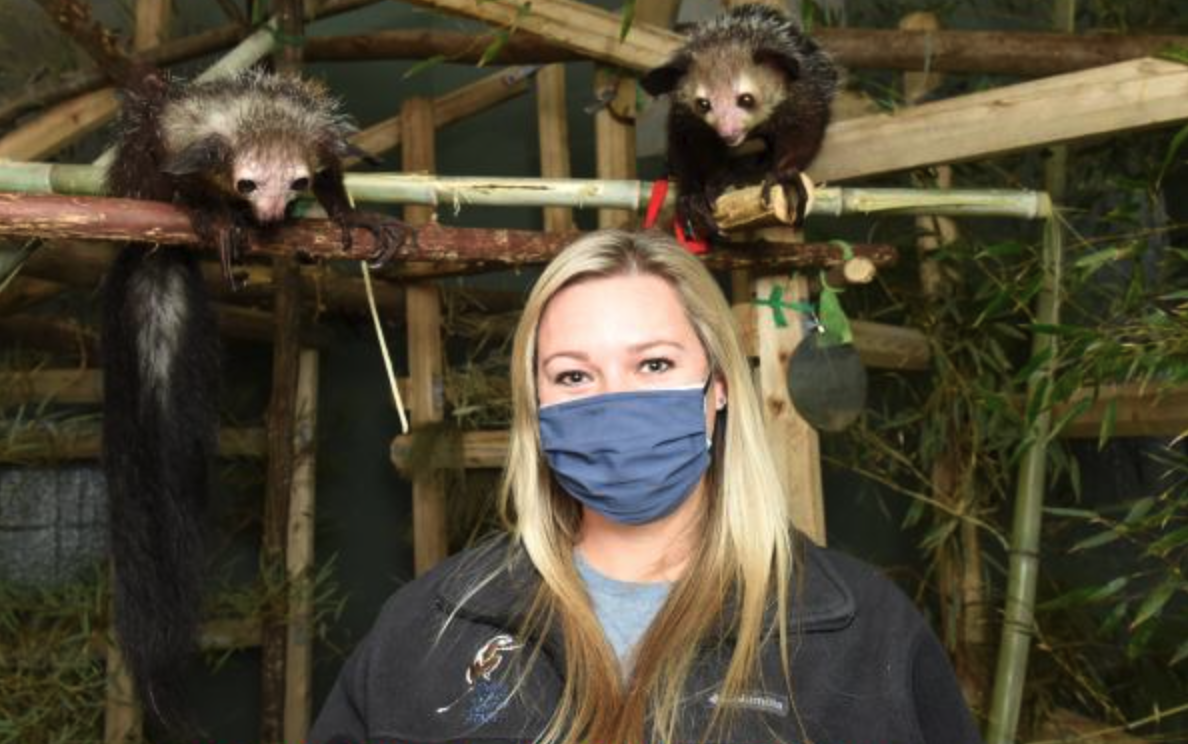
Kristin with aye-ayes at the DLC.
“From a young age, I knew I wanted to work with animals when I grew up—how and what was unclear, but animals, yes. There was always a connection that wasn’t understood but always present.
“When the time for attending college came, there wasn’t a hard choice for what to focus on; instead there was a rather difficult maze to get to my focus. I finally settled on a double major in biology and natural science. I had limited free time as I was also a student athlete and softball practices, games and travel took up a fair amount of the day’s hours. But I kept my focus and fed my desire to work with animals through my studies and a very part time job at a local animal shelter and volunteered at a wildlife rehab center on my day off. An internship at the National Aquarium in Baltimore as part of the Marine Mammal Stranding team and another as a keeper at the Erie Zoo rounded out my college days and I was ready for the real world.
“The struggle to break into the animal keeper world was real. So, I took a different route and landed a job as a sea turtle technician at Sea Island Resort in Georgia, an impressive place to work. I added experience managing sea turtle nests, strandings, and outreach. From Sea Island my road led to Loudoun County, Virginia where I worked as part of the Loudoun County Animal Control team. The shelter was very much advanced in their operations and I was introduced to and heavily involved with positive reinforcement training. This work influenced me greatly as a lot of my work was with animals who were on their last chance to modify behavior. This work resulted in not a few of these project animals coming home with me as I was giving them everything I had, racing against time and shelter space. This was one of the hardest jobs I have ever had.
“With additional experience now under my belt, I began searching for the keeper job I had envisioned for myself. I was fortunate enough to land an assistant aquarist position with the North Carolina Aquariums. My 12-year tenure resulted in several promotions. The first to aquarist, primarily responsible for otters, alligators, and turtles. I was also responsible for otter and sea turtle rehab. I then promoted to assistant curator and finally, husbandry curator where I oversaw all 1,600 animals comprising 230 species within the aquarium collection. I was able to work with many additional species in this role from raptors and venomous snakes to opossums and sharks. This position came with the responsibility of training all staff on handling large alligators, supervising the Sea Turtle Assistance and Rehabilitation Center and leading the startup partnership with the North American River Otter SSP coordinator to rehab and place non-releasable NC river otters in zoos and aquariums instead of the alternative of euthanasia. One of my most favorite experiences was attending Croc School at St. Augustine, Florida where I wasn’t sure if I would come home with all my limbs. I did have to sign a lengthy waiver!
“With the addition of two children to my family and the changes to life and priorities that it brings, it was time to seek the next chapter. After discovering the Duke Lemur Center a few years ago, I immediately knew it and its mission was on the short list of places I would consider leaving the aquarium for and I accepted a research position with DLC. I was admittedly nervous about straying from my comfort zone of animal husbandry, but a chance to join the DLC team was an opportunity I couldn’t pass up. The research position and the assistance I was able to provide to the husbandry team during Covid-19 restrictions eventually led me to my current position of assistant husbandry curator and back to my roots in husbandry. I feel very fortunate for the gifts of experience this research driven facility provides me every day about prosimian care. My main responsibility of supporting the 14-member altruistic team who delivers the very best animal welfare for the DLC’s 208 animals daily is quite frankly an honor. From feeding and cleaning to observing social hierarchies and breeding, the excellent animal welfare ensured by the husbandry team is amazing work. The management of the wonderfully large natural habitat enclosures and the work with multiple departments are also parts of the job I thoroughly enjoy.
“When I take time to reflect on my journey, I’m incredibly grateful I did not have a direct path that led me to a treasure. Instead, I followed a meandering stream with precious gemstones I gathered along the way. I am presently at the beginning of yet another gem-bound journey.”

